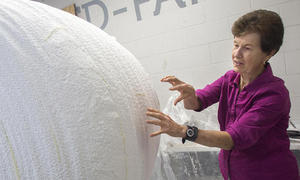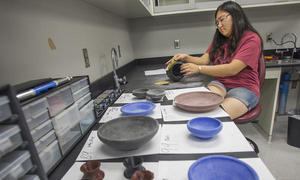Art you can touch: Ancient pottery recreated with 3-D printing
The Florida State University Museum of Fine Arts will host an art exhibit of ancient Etruscan and Roman pottery, which has been recreated with modern 3-D printing technology, making it interactive for the visually impaired because it can be picked up, touched and better understood through accompanying Braille materials.

Nancy de Grummond, the M. Lynette Thompson Professor of Classics at FSU, discusses the 5-foot Styrofoam recreation of a dolium, a storage jar found at Cetamura.
World-renowned archaeologist and art historian Nancy de Grummond, the M. Lynette Thompson Professor of Classics at FSU and director of excavations at Cetamura del Chianti in Italy, will serve as the curator of “Printing Ancient Pottery in 3-D: Etruscan Ceramics from Cetamura del Chianti,” a collaborative effort between the FSU Department of Classics in the College of Arts and Sciences, the Facility for Arts Research (FAR) and the Visual Disabilities Program in the College of Education.

Christina Cha, a doctoral student in classical archaeology, sands some of the 3-D printed replicas to be displayed at the Museum of Fine Arts.
The exhibit will open Friday, Oct. 16, with a special session for visitors on International Archaeology Day, Saturday, Oct. 17. Visitors can take a “touch tour” guided by volunteers from the FSU Student Archaeology Club and can handle any of the 28 objects on display. The show will conclude Sunday, Nov. 15.
The 3-D pots were created under the supervision of Windham Graves, coordinator of the FAR.
“These objects are ones you can hold and touch and that’s something you can’t do in a normal museum,” Graves said.
While 3-D printing adds a degree of novelty to the show, the technology was used for a greater purpose.
“When telling a visually impaired person about my work, I can’t show them slides but I can hand them a 3-D printed goblet from Cetamura and they can feel the shape and size of the vase and hold it by its two handles,” de Grummond said. “We can explain that this was used for drinking wine. The person who can’t see can relate to that and as a way of accessing these ancient cultures.”
Sandra Lewis, a professor in the Visual Disabilities Program, and her students are working on the project, fabricating a Braille guide to the objects. Her students will also assist in giving tours of the exhibit for a visually impaired audience.
To create the 3-D models, an artist on de Grummond’s team of researchers designed cross sections of the artifacts, which were sent to Graves at FAR. The scans of the designs were input into a 3-D modeling program — in this particular case, Rhinoceros 3D — where the models of a cross section can spin on a spit to get a symmetric 3-D image.
The artifacts are printed out of polyactide plastic (PLA), which is a biodegradable, corn-based material. At the FAR, there are two small 3-D printers that are used to make smaller objects. The printers can take around an hour to print a small vase or plate. For larger-scale objects, a multimodal additive printer (MMAP) is used. This machine can print objects with dimensions up to 8 feet by 6 feet by 4 feet, and is being used to create a 5-foot storage jar, or dolium, found at Cetamura out of stacked Styrofoam sheets. After the objects are printed, students from the Department of Classics sand them down and paint them to create authentic looking pieces of pottery.
Printing pieces of Etruscan pottery out of plastic and foam is highly affordable, according to Graves. The plastic used in this project costs $30 per kilogram, and just around two kilograms of material is being used to print different models, with duplicates — about 40 objects in all.
The excavation site at Cetamura del Chianti is an ancient hilltop in the center of Chianti, Tuscany, which was settled by the Etruscans and Romans. Since 1973, students and faculty from Florida State have been conducting research there, where a deep well full of ancient offerings from the Etruscan people to their gods was found. In the 1980s, de Grummond became the director of the Cetamura excavations, and her goal was to make it to the bottom of the well. Over the course of 13 campaigns, FSU teams have dug down over 100 feet within the well.
The Etruscans were the first great civilization in Italy, who spoke a different language than the Romans. Written texts are scarce, and that makes the archaeology of the site that much more important.
In her time studying the Cetamura site, de Grummond has discovered thousands of artifacts. Rather than import such ancient objects from Italy, de Grummond had a bright idea: To recreate them with 3-D printing.
The upcoming Etruscan pottery exhibit is not the first to create a visually accessible museum experience, but it makes use of the tools of 3-D printing for unique audiences.
“I think there’s a lot of interest in doing this kind of thing. At a museum you expect to look,” de Grummond said, “but we want to give our visitors a chance to touch, to hold artifacts and works of art. We hope to make an innovative contribution to this approach to learning about art and archaeology.”

